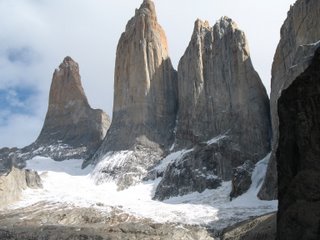Buenos Aires
My journey begins in Buenos Aires where the wide avenues, leafy parks and street cafes add a very European flavour to Argentina´s capital. The country is still in the process of recovering from the economic disaster of December 2001. Indeed this only adds to its attraction for visitors, its possible to eat out in some style for less than 5 pounds. The gigantic steaks are probably the world´s finest and the strong Italian influence results in some excellent pasta and pizza dishes. So far, my Spanish has just about got me by, although the conversation has tended to revert to English in some situations. I´m hoping that by the end of the 4 months, this won´t be the case.
Although Argentina´s name means land of silver in latin, the Spanish never found any here and Buenos Aires was really to thrive as a port city and used to transport the silver and gold found in Peru and modern day Bolivia back to Spain.
Although Argentina´s name means land of silver in latin, the Spanish never found any here and Buenos Aires was really to thrive as a port city and used to transport the silver and gold found in Peru and modern day Bolivia back to Spain.

A pleasant stroll south from my hostel in the microcentro took me down Avenida Florida, the citys main shopping street to the Plaza del Mayo. This grand square is surrounded by impressive colonial buildings, including the pink facade of La Casa Rosada, the presidential offices. South of the centre via the antique shops of San Telmo, lies La Boca, home to the famous Juniors football club and the colourfully painted houses and businesses of El Caminito. Perhaps the capitals most famous attraction however, is the Recoleta Cemetry, where the remains of the wealthy porteños of recent centuries lie, most notably those of Argentina´s much revered first lady Evita. This concrete labyrinth of tomb filled passageways is as much a homage to art as it is to the city´s former inhabitants. Its an impressive and altogether unsual sight.
Although Evita and other living legends such as Diego Maradona are much reverred, the star of the show in this country is General Jose de San Martin, Liberator of Argentina, Uruguay and Paraguay. His statue occupies pride of place in many towns and cities across the country and is a talisman to many - a sign of their independence.
Although Evita and other living legends such as Diego Maradona are much reverred, the star of the show in this country is General Jose de San Martin, Liberator of Argentina, Uruguay and Paraguay. His statue occupies pride of place in many towns and cities across the country and is a talisman to many - a sign of their independence.


A short ferry ride across the Rio de la Plata lies the Uruguayan town of Colonia del Sacramento. It was founded by the Portugese in 1680 and functioned as a smugglers port. Throughout the 18th century it was the subject of struggles between the Portugese and Spanish and changed hands on numerous occaisions. The bougainvillea lined cobbled streets retain the ancient colonial charm and it proved to be a pleasant place to kick back and relax for 24 hours before returning to Buenos Aires. Tomorrow I fly to Ushuaia and onto the remote wilderness of Tierra del Fuego and the wide open spaces of Patagonia.


0 Comments:
Post a Comment
<< Home